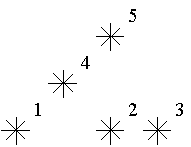| Time Limit: 1000MS | Memory Limit: 65536K | |
| Total Submissions: 35197 | Accepted: 15277 |
Description

For example, look at the map shown on the figure above. Level of the star number 5 is equal to 3 (it's formed by three stars with a numbers 1, 2 and 4). And the levels of the stars numbered by 2 and 4 are 1. At this map there are only one star of the level 0, two stars of the level 1, one star of the level 2, and one star of the level 3.
You are to write a program that will count the amounts of the stars of each level on a given map.
Input
Output
Sample Input
5 1 1 5 1 7 1 3 3 5 5
Sample Output
1 2 1 1 0
Hint
Source
是时候捡起来线段树和树状数组了……
题目大意:
在坐标上有n个星星,如果某个星星坐标为(x, y), 它的左下位置为:(x0,y0),x0<=x 且y0<=y。如果左下位置有a个星星,就表示这个星星属于level x
按照y递增,如果y相同则x递增的顺序给出n个星星,求出所有level水平的数量。
首先这道题看了网上的解题报告:
线段树解法:
#include<iostream>
#include<cstdio>
#include<cstring>
#define mid ((left+right)>>1)
#define lson rt<<1,left,mid
#define rson rt<<1|1,mid+1,right
using namespace std;
const int MAXN = 32005;
int sum[MAXN<<2],level[MAXN<<2];
void update(int rt,int left,int right,int data){
++sum[rt];
if(left==right) return;
if(data <= mid) update(lson,data);
else update(rson,data);
}
int query(int rt,int left,int right,int l,int r){
if(left==l && right==r) {
return sum[rt];
}
int m = mid;
if(r <= m) return query(lson,l,r);
else if(l > m) return query(rson,l,r);
else return query(lson,l,m)+query(rson,m+1,r);
}
int main(){
int n,x,y;
while(~scanf("%d",&n)){
memset(sum, 0, sizeof(sum));
memset(level, 0, sizeof(level));
for(int i=0; i<n; ++i){
scanf("%d%d",&x,&y);
++x;
++level[query(1,1,MAXN,1,x)];
update(1,1,MAXN,x);
}
for(int i=0; i<n; ++i)
printf("%d\n",level[i]);
}
return 0;
}树状数组解法:
#include<iostream>
#include<cstdio>
#include<cstring>
using namespace std;
const int MAXN = 32005;
int c[MAXN],level[MAXN],n;
int lowbit(int x){return x & (-x);}
// 求前n项的和
int sum(int n){
int sum = 0;
while(n > 0){
sum += c[n];
n -= lowbit(n);
}
return sum;
}
// 增加某个元素的大小
void add(int x){
while(x <= MAXN){
++c[x];
x += lowbit(x);
}
}
int main(){
int n,x,y;
while(~scanf("%d",&n)){
memset(level, 0, sizeof(level));
memset(c, 0, sizeof(c));
for(int i=0; i<n; ++i) {
scanf("%d%d",&x,&y);
++x;
level[sum(x)]++;
add(x);
}
for(int i=0; i<n; ++i)
printf("%d\n",level[i]);
}
return 0;
}相对的我还是比较喜欢树状数组的,今天看懂的一些小部分还是记录一下的好:
首先,lowbit(x)是很常见的操作,作用为取当前数在二进制表示中最低位的1,比如10111000取lowbit就是1000,定义上则是 return x&(-x)
咱们来用这个来说明下意思:
使用lowbit的时候,一般有向上和向下(即加减)之分:
求sum的时候,把区间一个接着一个的加起来,就是 i=x;i>0;i-=lowbit(i)
n = n – lowbit(n)这一步实际上等价于将n的二进制的最后一个1减去,即一个接着一个的获取这个区间内的和,把这些和加起来就得到了所需要的和。
当我们要把其中某个点加1的时候,是不是应该要把包含有它的所有区间记录也加一呢,那么问题来了,哪些有呢,那就是i=x;i<=maxn;i+=lowbit(i)
知道了这些至少这道题就能解了,线段树神马的……咱以后再说好啦~ 赶紧去写作业哦~~~
啊然后这是这道题我的Code:
#include<cstdio>
#include<iostream>
#include<algorithm>
using namespace std;
#define maxn 32001
int arr[maxn]={0};
int lowbit(int i){return (i&-i);}
void update(int x,int val){for(int i=x;i<=maxn;i+=lowbit(i))arr[i]+=val;}
int getsum(int x)
{
int temp=0;
for(int i=x;i>0;i-=lowbit(i)) temp+=arr[i];
return temp;
}
int main()
{
int stars[maxn]={0};
int n; scanf("%d",&n);
for(int i=1;i<=n;i++)
{
int x,y; scanf("%d%d",&x,&y);
int l=getsum(x+1); stars[l]++;
update(x+1,1);
}
for(int i=0;i<n;i++) printf("%d\n",stars[i]);
return 0;
}





 本文深入探讨了一种算法,用于计算天文星图中各星体的水平等级分布。通过输入星体坐标,算法能准确计算并输出每个等级对应的星体数量,展现了在天文学领域应用算法解决实际问题的能力。
本文深入探讨了一种算法,用于计算天文星图中各星体的水平等级分布。通过输入星体坐标,算法能准确计算并输出每个等级对应的星体数量,展现了在天文学领域应用算法解决实际问题的能力。

















 407
407

 被折叠的 条评论
为什么被折叠?
被折叠的 条评论
为什么被折叠?










